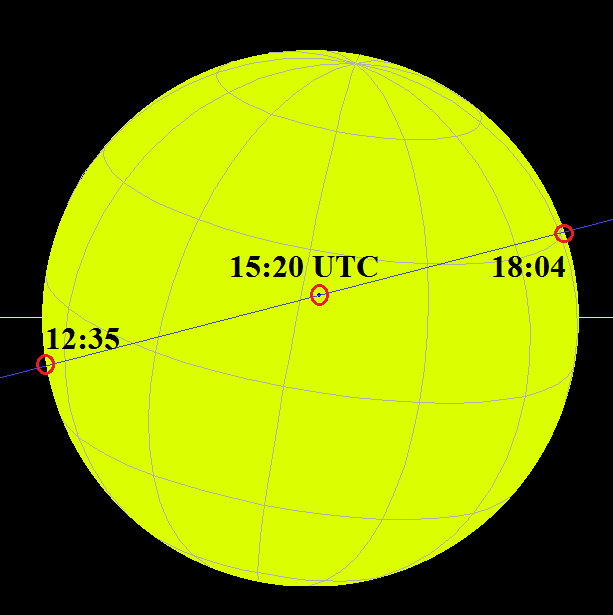Il transito di Mercurio sul Sole
Il transito di Mercurio sul Sole in una frase: “Sono stato più fortunato dei ricercatori successivi che videro Mercurio, il dio volante, nel Sole. L’ho trovato e visto dove nessun altro lo aveva mai scorto prima”.
Pierre Gassendi, scienziato francese (1592-1655).
Vale comunque la pena di ripercorrere la storia dei transiti di Mercurio sul Sole dall’invenzione del telescopio.
Il passaggio (o transito) di Mercurio sul disco solare non è un fenomeno molto frequente (non più di 14 volte in un secolo) perché l’orbita del pianeta è inclinata di quasi 7° sul piano dell’eclittica. Si tratta di una specie di eclisse nel quale i protagonisti sono Sole, Terra e Mercurio. Ancora più raro è il transito di Venere (una dozzina di volte ogni mille anni). Da ciò discende che il transito possa interessare esclusivamente i pianeti interni fra Terra e Sole.
Se le orbite attorno al Sole di questi pianeti si trovassero sullo stesso piano dell’orbita terrestre potremmo assistere ad un transito a ogni congiunzione inferiore, quando i due pianeti vengono a trovarsi tra la Terra e il Sole. I transiti di Mercurio possono verificarsi soltanto in maggio o in novembre. I passaggi di maggio si verificano con Mercurio in prossimità dell’afelio, mentre quelli di novembre si svolgono in prossimità del perielio.
I transiti di novembre sono più frequenti nel rapporto di 7 a 3. I transiti più lunghi, quelli di maggio, durano per quasi 9 ore.
In un transito vi sono 5 fasi:
- il contatto esterno (ovvero il primo contatto del disco planetario su quello solare);
- il contatto interno (ovvero quando il disco planetario si distacca completamente da quello solare);la fase massima del fenomeno (ovvero la minima distanza del disco planetario dal centro del Sole);
- il contatto interno (ovvero l’ultimo istante in cui il disco planetario è distaccato completamente da quello solare);
- il contatto esterno (ovvero l’ultimo contatto del disco planetario su quello solare).
(continua)
English Version
The transit of Mercury on the Sun
The transit of Mercury on the Sun: “I was luckier than the subsequent researchers who saw Mercury, the flying god, in the Sun. I found it and saw where no one else had ever seen it before.”
Pierre Gassendi, French scientist (1592-1655).
However, it is worth retracing the history of Mercury on the Sun from the invention of the telescope.
The passage (or transit) of Mercury on the solar disk is not a very frequent phenomenon (not more than 14 times in a century) because the planet’s orbit is inclined by almost 7 ° on the plane of the ecliptic.
It is some kind of eclipse in which the protagonists are Sun, Earth and Mercury. Even more rare is the transit of Venus (a dozen times every thousand years). From this it follows that the transit can only affect the inner planets between the Earth and the Sun.
If the orbits around the Sun of these planets were on the same level as the Earth’s orbit we could see a transit at each lower junction, when the two planets are to be between the Earth and the Sun.
Mercury transits can occur only in May or November.
The May passages occur with Mercury near the aphelion, while those of November take place near the perihelion.
The transits of November are more frequent in the ratio of 7 to 3.
The longer transits, those of May, last for almost 9 hours. In a transit there are 5 phases:
- the external contact (or the first contact of the planetary disk on that solar)
- internal contact (ie when the planetary disk is completely detached from the solar one)
- the maximum phase of the phenomenon (ie the minimum distance of the planetary disk from the center of the Sun)
- the internal contact (that is the last moment in which the planetary disk is completely detached from the solar one)
- the external contact (that is the last contact of the planetary disk on the solar one)
(To be continued)
Latina (latinorum) versio
De Mercurii transito per Solem
Per quod transit de Mercurio sol: “Qui vidit me erat fortunatissimus habebatur subsequent Inquisitores Mercurii, dei gubernaculo rota in solis. Et vidi, et non inveni ibi non est aliud quam umquam ante eum”.
Pierre Gassendi, physicus Gallicus (1592-1655).
Operae pretium est referre ad historiam Mercurii transits enim sol cum invention telescopiorum doctrina. Locus s (vel transitu) de Mercurius Solaris disci, non nimis frequentes rei (non magis quam temporibus in saeculum XIV) orbita planetae, quia sunt prope VII ° inclinabitur in superficie lineæ eclipticæ.
Ex quo obscuratus est sol actores sunt Terra Mercurium. Magis rara transitu Veneris (singulos duodecim annos). Inde sequitur transi nocebit interioris planetarum humus Sole Si orbium circa Solem Venus esset aequalis Terrae orbita potuit adiuvare transitus singulis minus conjunctio cum duae sint ut inter terram et percussit sol.
Mercurii transitus fieri potest sive in Novembre. Illa vero Mercurium prope aphelion Maii experiri vos dum in November accipere locum qui prope perihelion. Ad frequentes sunt in duplicata ratione transit November VII 3.
Quod iam non est transitus, qui Maii, ore.In duos pro uno fere IX ad V gradus transitu sunt;
- externi contactus (id est, in qua primum contactum orbis planete solaris)
- contactus interioris (Horace solvit omnino ex solis discus planetarum)
- rei summam Phase (id est minimum distantia planetae a centro Solis disco)
- contactus interioris (id quod ultimo plane discus planetarum a Sole remota)
- externum commercium (id postremum in disco Solis calendarium contactum Planetaria)
(Continuat)
News e spunti ulteriori su…
Calendario della Luna Verde
Transito Mercurio 2019
